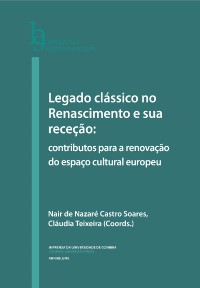Please use this identifier to cite or link to this item:
https://hdl.handle.net/10316.2/42995| Title: | Retórica e encontro de culturas: jesuítas portugueses apresentam o Japão à Cúria Romana em 1585 | Other Titles: | Rhetoric and the Meeting of Cultures: Portuguese Jesuits Present Japan to the Roman Curia in 1585 | Authors: | Pereira, Belmiro Fernandes | Keywords: | rhetoric;Jesuits;Japan;oratio oboedientialis;retórica;Jesuítas;Japão;oratio oboedientialis | Issue Date: | 2017 | Publisher: | Imprensa da Universidade de Coimbra | Journal: | http://hdl.handle.net/10316.2/42974 | Abstract: | In the very first colleges of the Society of Jesus the teaching of rhetoric acquired an important position: only through an eloquence informed by the precepts and practice of the ancients would study progress and communication be achieved in any circumstance or place. As is well known, this pedagogical experience resulted
in the establishment of a complete programme of instruction in rhetoric in the final
version of the Ratio Studiorum. The desire, which at the beginning of the century encouraged Diogo de Gouveia to create 50 study stipends at the Parisian Saint Barbara
College (in order to educate theologians for the evangelization of the discovered and
conquered territories), was finally satisfied when, in 1555, D. João III gave the Jesuits
the Colégio das Artes in Coimbra. If the apologetic purpose was not absent from the literary education on offer there, the advantages of preparation in rhetoric were
already noted in the letters sent from Brazil and from Asia by the first Jesuit missionaries.
Four Japanese princes, accompanied by two Jesuits, left Nagasaki for Rome
in February 1582, in order to swear their allegiance to the Pope. The oratio oboedientialis, directed at Pope Gregory XIII, was presented by the experienced Latin orator
Father Gaspar Gonçalves. Another Jesuit, Duarte de Sande, wrote an extraordinary
travel book on the eight-year long journey of the Japanese aristocrats which appeared
in Macao in 1590 (cf. Américo da Costa Ramalho, Duarte de Sande: Diálogo sobre
a Missão dos Embaixadores japoneses à Cúria Romana, Macau, Fundação Oriente,
1997). It is from the perspective of the usefulness of the study of rhetoric for evangelization and for the intercultural dialogue that the Oratio habita a Gaspare Consaluo Lusitano in Legatorum Iaponiorum introitu (Rome, apud Franciscum Zanettum,
1585) will be analysed. Já nos primeiros colégios da Companhia de Jesus o ensino da retórica adquirira posição de privilégio: só uma eloquentia moldada pelos preceitos e pela prática dos antigos permitiria progredir nos estudos e comunicar eficazmente em qualquer circunstância e lugar. Dessa experiência pedagógica resultou, como se sabe, a consagração de um completo programa de instrução retórica na versão definitiva da Ratio Studiorum. O desejo que no início do século animara Diogo de Teive a criar 50 bolsas de estudo no colégio parisiense de Santa Bárbara - formar teólogos para a evangelização dos territórios descobertos e conquistados - veio por fim a ser satisfeito quando D. João III entregou aos jesuítas em 1555 o Colégio das Artes de Coimbra. Se a finalidade apologética não está ausente da formação literária aí oferecida, as vantagens da preparação retórica já eram notadas nas cartas ânuas enviadas do Brasil e da Ásia pelos primeiros missionários jesuítas. Quatro príncipes japoneses, acompanhados por dois jesuítas, partiram de Nagasáqui em fevereiro de 1582 com destino a Roma, para prestarem obediência ao Papa. A oratio oboedientialis, dirigida a Gregório XIII, foi apresentada pelo P. Gaspar Gonçalves, experiente orador latino. Sobre a longa jornada dos aristocratas nipónicos, que durou oito anos, compôs Duarte de Sande, outro jesuíta, o De missione legatorum Iaponensium, um extraordinário livro de viagens que veio a lume em Macau em 1590 (vd. Américo da Costa Ramalho, Diálogo sobre a Missão dos Embaixadores japoneses à Cúria Romana, Macau, Fundação Oriente, 1997). Será, pois, nesta perspetiva, da utilidade dos estudos retóricos para a evangelização e para o diálogo intercultural, que se analisará a Oratio habita a Gaspare Consaluo Lusitano in Legatorum Iaponiorum introitu (Roma, apud Franciscum Zanettum, 1585). |
URI: | https://hdl.handle.net/10316.2/42995 | ISBN: | 978-989-26-1292-8 978-989-26-1293-5 (PDF) |
ISSN: | 2182‑8814 | DOI: | 10.14195/978-989-26-1293-5_20 | Rights: | open access |
| Appears in Collections: | Legado clássico no Renascimento e sua receção: contributos para a renovação do espaço cultural europeu |
Files in This Item:
| File | Description | Size | Format | |
|---|---|---|---|---|
| retorica_e_encontro_de_culturas.pdf | 2.11 MB | Adobe PDF |  |
Items in DSpace are protected by copyright, with all rights reserved, unless otherwise indicated.
